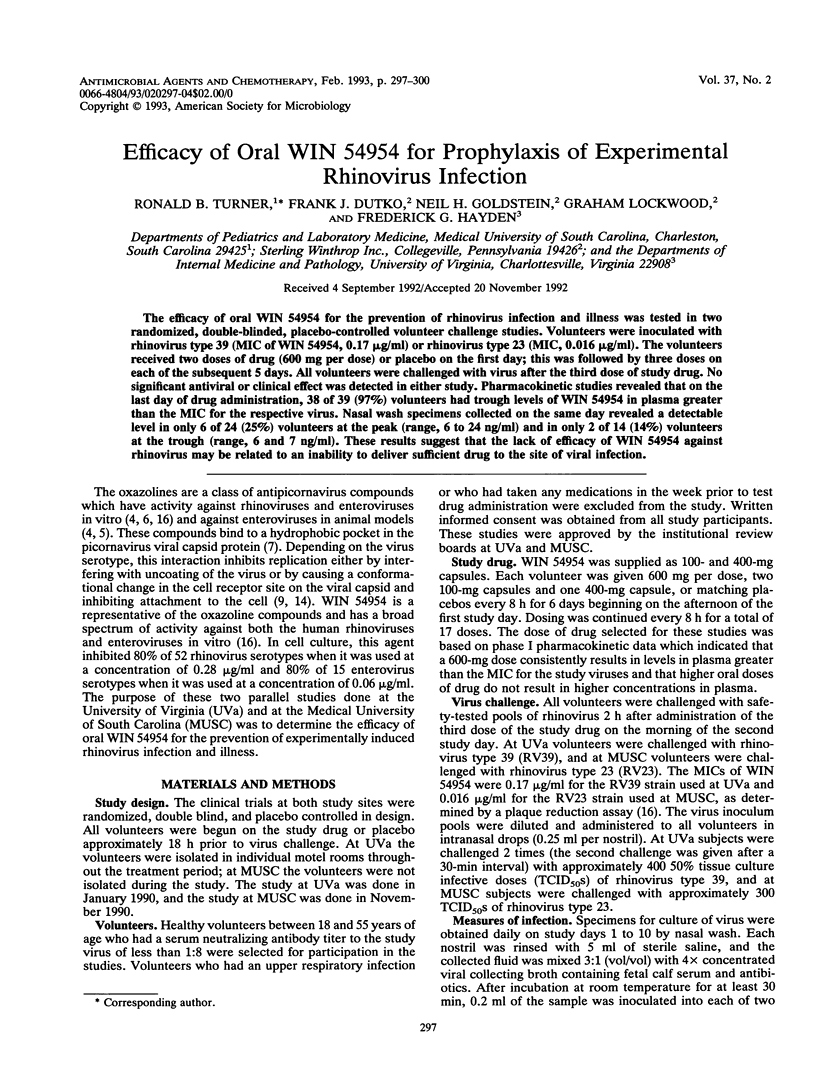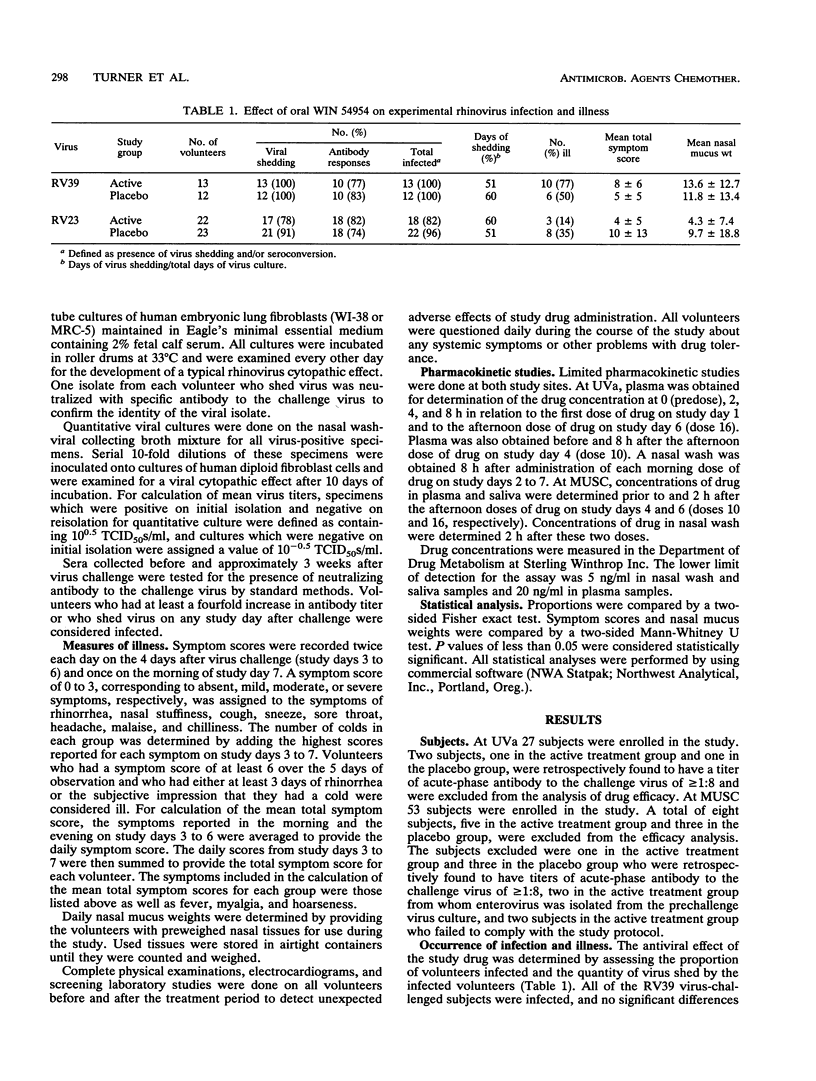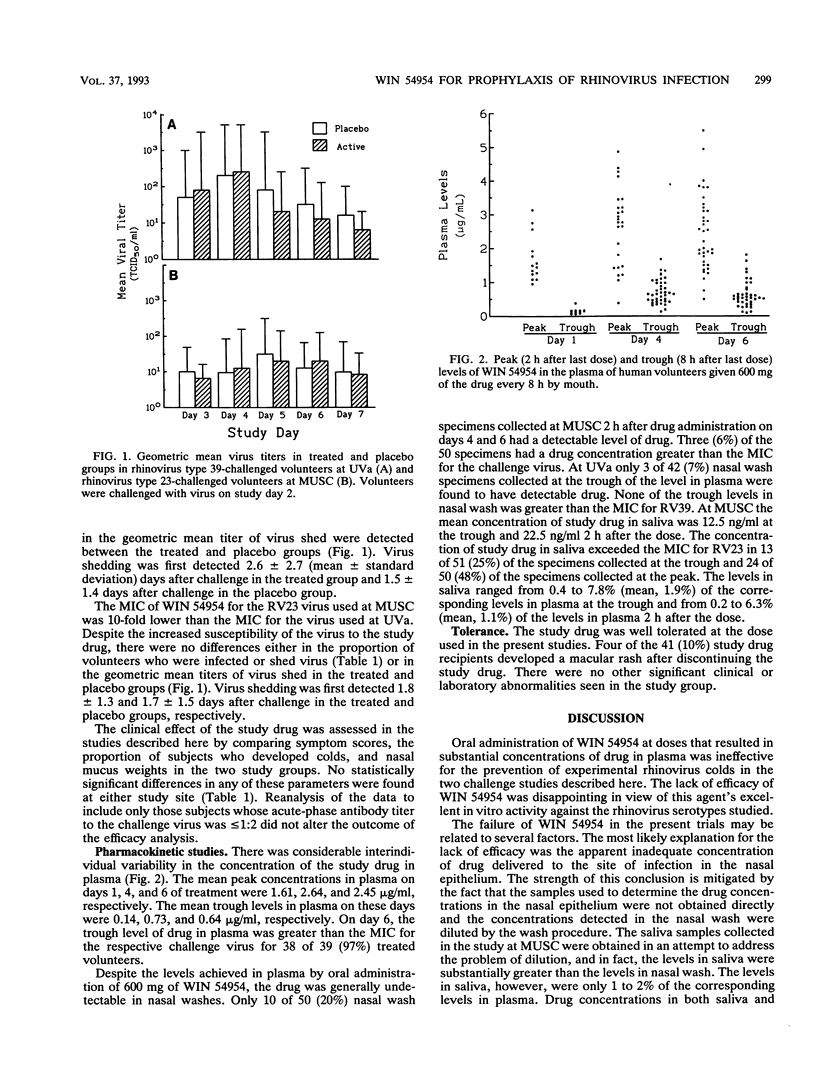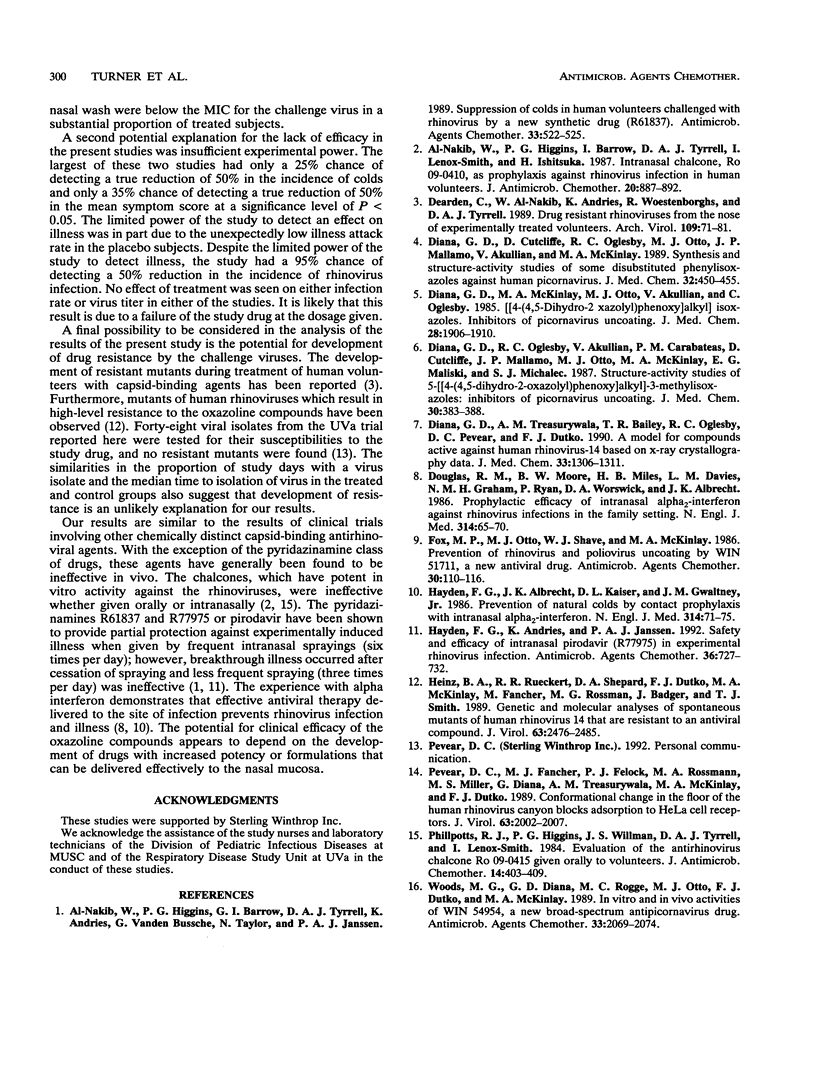Abstract
The efficacy of oral WIN 54954 for the prevention of rhinovirus infection and illness was tested in two randomized, double-blinded, placebo-controlled volunteer challenge studies. Volunteers were inoculated with rhinovirus type 39 (MIC of WIN 54954, 0.17 microgram/ml) or rhinovirus type 23 (MIC, 0.016 microgram/ml). The volunteers received two doses of drug (600 mg per dose) or placebo on the first day; this was followed by three doses on each of the subsequent 5 days. All volunteers were challenged with virus after the third dose of study drug. No significant antiviral or clinical effect was detected in either study. Pharmacokinetic studies revealed that on the last day of drug administration, 38 of 39 (97%) volunteers had trough levels of WIN 54954 in plasma greater than the MIC for the respective virus. Nasal wash specimens collected on the same day revealed a detectable level in only 6 of 24 (25%) volunteers at the peak (range, 6 to 24 ng/ml) and in only 2 of 14 (14%) volunteers at the trough (range, 6 and 7 ng/ml). These results suggest that the lack of efficacy of WIN 54954 against rhinovirus may be related to an inability to deliver sufficient drug to the site of viral infection.
Full text
PDF



Selected References
These references are in PubMed. This may not be the complete list of references from this article.
- Al-Nakib W., Higgins P. G., Barrow I., Tyrrell D. A., Lenox-Smith I., Ishitsuka H. Intranasal chalcone, Ro 09-0410, as prophylaxis against rhinovirus infection in human volunteers. J Antimicrob Chemother. 1987 Dec;20(6):887–892. doi: 10.1093/jac/20.6.887. [DOI] [PubMed] [Google Scholar]
- Dearden C., al-Nakib W., Andries K., Woestenborghs R., Tyrrell D. A. Drug resistant rhinoviruses from the nose of experimentally treated volunteers. Arch Virol. 1989;109(1-2):71–81. doi: 10.1007/BF01310519. [DOI] [PubMed] [Google Scholar]
- Diana G. D., Cutcliffe D., Oglesby R. C., Otto M. J., Mallamo J. P., Akullian V., McKinlay M. A. Synthesis and structure-activity studies of some disubstituted phenylisoxazoles against human picornavirus. J Med Chem. 1989 Feb;32(2):450–455. doi: 10.1021/jm00122a027. [DOI] [PubMed] [Google Scholar]
- Diana G. D., McKinlay M. A., Otto M. J., Akullian V., Oglesby C. [[(4,5-Dihydro-2-oxazolyl)phenoxy]alkyl]isoxazoles. Inhibitors of picornavirus uncoating. J Med Chem. 1985 Dec;28(12):1906–1910. doi: 10.1021/jm00150a025. [DOI] [PubMed] [Google Scholar]
- Diana G. D., Oglesby R. C., Akullian V., Carabateas P. M., Cutcliffe D., Mallamo J. P., Otto M. J., McKinlay M. A., Maliski E. G., Michalec S. J. Structure-activity studies of 5-[[4-(4,5-dihydro-2-oxazolyl) phenoxy]alkyl]-3-methylisoxazoles: inhibitors of picornavirus uncoating. J Med Chem. 1987 Feb;30(2):383–388. doi: 10.1021/jm00385a021. [DOI] [PubMed] [Google Scholar]
- Diana G. D., Treasurywala A. M., Bailey T. R., Oglesby R. C., Pevear D. C., Dutko F. J. A model for compounds active against human rhinovirus-14 based on X-ray crystallography data. J Med Chem. 1990 May;33(5):1306–1311. doi: 10.1021/jm00167a006. [DOI] [PubMed] [Google Scholar]
- Douglas R. M., Moore B. W., Miles H. B., Davies L. M., Graham N. M., Ryan P., Worswick D. A., Albrecht J. K. Prophylactic efficacy of intranasal alpha 2-interferon against rhinovirus infections in the family setting. N Engl J Med. 1986 Jan 9;314(2):65–70. doi: 10.1056/NEJM198601093140201. [DOI] [PubMed] [Google Scholar]
- Fox M. P., Otto M. J., McKinlay M. A. Prevention of rhinovirus and poliovirus uncoating by WIN 51711, a new antiviral drug. Antimicrob Agents Chemother. 1986 Jul;30(1):110–116. doi: 10.1128/aac.30.1.110. [DOI] [PMC free article] [PubMed] [Google Scholar]
- Hayden F. G., Albrecht J. K., Kaiser D. L., Gwaltney J. M., Jr Prevention of natural colds by contact prophylaxis with intranasal alpha 2-interferon. N Engl J Med. 1986 Jan 9;314(2):71–75. doi: 10.1056/NEJM198601093140202. [DOI] [PubMed] [Google Scholar]
- Hayden F. G., Andries K., Janssen P. A. Safety and efficacy of intranasal pirodavir (R77975) in experimental rhinovirus infection. Antimicrob Agents Chemother. 1992 Apr;36(4):727–732. doi: 10.1128/aac.36.4.727. [DOI] [PMC free article] [PubMed] [Google Scholar]
- Heinz B. A., Rueckert R. R., Shepard D. A., Dutko F. J., McKinlay M. A., Fancher M., Rossmann M. G., Badger J., Smith T. J. Genetic and molecular analyses of spontaneous mutants of human rhinovirus 14 that are resistant to an antiviral compound. J Virol. 1989 Jun;63(6):2476–2485. doi: 10.1128/jvi.63.6.2476-2485.1989. [DOI] [PMC free article] [PubMed] [Google Scholar]
- Pevear D. C., Fancher M. J., Felock P. J., Rossmann M. G., Miller M. S., Diana G., Treasurywala A. M., McKinlay M. A., Dutko F. J. Conformational change in the floor of the human rhinovirus canyon blocks adsorption to HeLa cell receptors. J Virol. 1989 May;63(5):2002–2007. doi: 10.1128/jvi.63.5.2002-2007.1989. [DOI] [PMC free article] [PubMed] [Google Scholar]
- Phillpotts R. J., Higgins P. G., Willman J. S., Tyrrell D. A., Lenox-Smith I. Evaluation of the antirhinovirus chalcone Ro 09-0415 given orally to volunteers. J Antimicrob Chemother. 1984 Oct;14(4):403–409. doi: 10.1093/jac/14.4.403. [DOI] [PubMed] [Google Scholar]
- Woods M. G., Diana G. D., Rogge M. C., Otto M. J., Dutko F. J., McKinlay M. A. In vitro and in vivo activities of WIN 54954, a new broad-spectrum antipicornavirus drug. Antimicrob Agents Chemother. 1989 Dec;33(12):2069–2074. doi: 10.1128/aac.33.12.2069. [DOI] [PMC free article] [PubMed] [Google Scholar]
- al-Nakib W., Higgins P. G., Barrow G. I., Tyrrell D. A., Andries K., Vanden Bussche G., Taylor N., Janssen P. A. Suppression of colds in human volunteers challenged with rhinovirus by a new synthetic drug (R61837). Antimicrob Agents Chemother. 1989 Apr;33(4):522–525. doi: 10.1128/aac.33.4.522. [DOI] [PMC free article] [PubMed] [Google Scholar]


